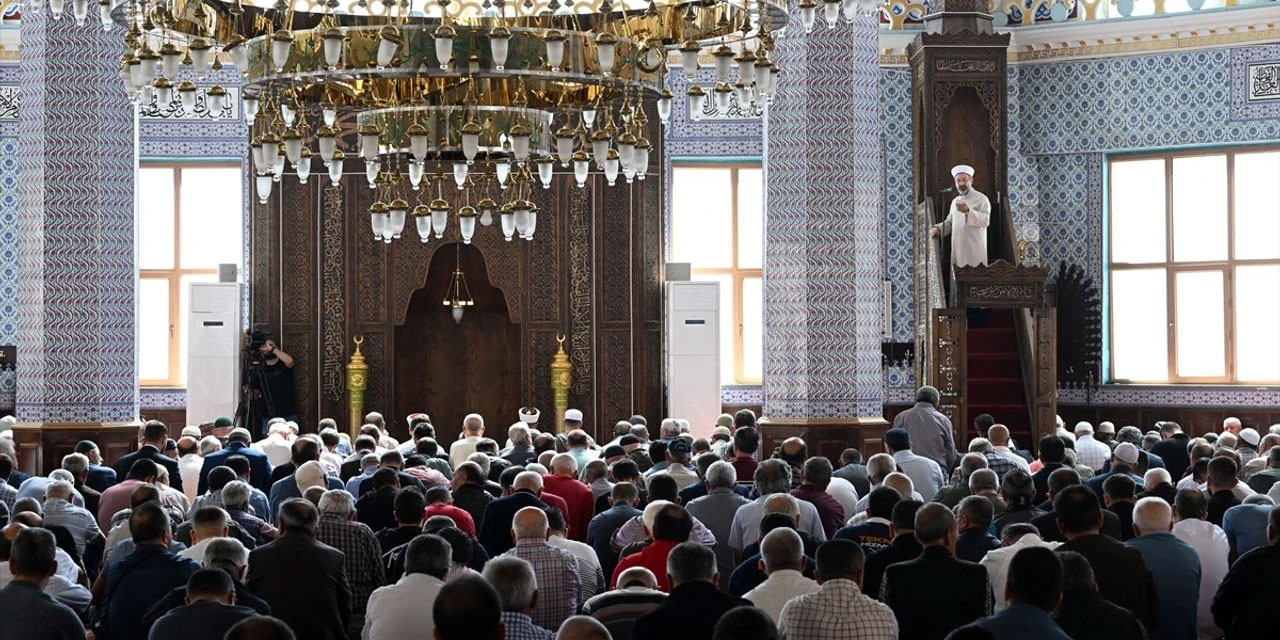
Salahattin ALTUNDAĞ
Kurbânın Ardındaki Derîn Sorgulamalar: Sorular ve Cevâplarla İslâm'ın Temel Ritüelleri
"Allâh (cc), neden Hz. İbrâhim'den (as) oğlu Hz. İsmâil'i (as) kurbân etmesini talep etmiştir?"
Allâh'ın Hz. İbrâhim'den (as) oğlu Hz. İsmâil'i (as) kurbân etmesini talep etmesi, İslâm literatürüne göre, bir imtihân (deneme) ve teslimiyetin sembolü olarak kabûl edilir. Allâh (cc), Hz. İbrâhim'in (as) kendisine olan inancını, teslimiyetini ve itâatini sınamak için bu talepte bulunmuştur. Hz. İbrâhim'in (as) bu talebe kararlı bir şekilde uyması ve Hz. İsmâil'in (as) de bu duruma teslim olması, her ikisinin de Allâh'a olan tam teslimiyetlerini ve itâatlerini gösterir. Bu olây, İslâm'da, itâat ve teslimiyetin sembolü olarak anılmakta ve Kurbân Bayramı'nda bu olâyın anısına kurbân kesilmektedir. Hz. İbrâhim (as) ve oğlu Hz. İsmâil'in (as) bu hâdisesi, Allâh'a olan inanç, teslimiyet ve itâatin somut bir örneği olarak kabûl edilir ve Müslümânlar için örnek teşkil eder.
Padişâh ve halk arasındaki ilişkiye bir benzetme yapmak konuyu daha iyi anlamamıza yardımcı olabilir. Bir hükümdâr (Allâh'ı temsîl eder) halkının kendisine olan sadâkâtini ve teslimiyetini görmek ister. Bunun için, hükümdâr, bir kişiye (Hz. İbrâhim'i temsîl eder) en değerli şeyini (Hz. İsmâil'i temsîl eder) fedâ etmesini ister. Bu, tam bir sadâkât ve teslimiyet eylemi olacaktır.
Ancak, hükümdârın asıl amacı, bu kişinin en değerli varlığını gerçekten fedâ etmesi değil, onun ne kadar sâdık ve teslimiyet gösterebileceğini test etmektir. Bu nedenle, hükümdâr son anda o kişiye müdâhale eder ve onun en değerli varlığını fedâ etmesini engeller.
Ancak bu olâyın ardından, hükümdâr, kişinin hâlâ kendisine olan bağlılığını ve teslimiyetini göstermesini ister. Bir değerli malını (kurbân edilen hayvânı temsîl eder) halkla paylaşmasını talep eder. Bu, halk arasında yardımseverliği ve eşitliği teşvîk eder, aynı zamânda kişinin hükümdâra olan bağlılığını ve teslimiyetini de teyît eder.
"Allâh'ın Hz. İbrâhim'den (as) böyle bir deneme talep etmesinin sebebi nedir? İnsanı kurbân etme eylemi o dönemde bir âdet miydi, yoksa bu durumun başka bir nedeni olabilir mi?"
Hz. İbrâhim'in (as) oğlu Hz. İsmâil'i (as) kurbân etmesi talebinin, İslâmî geleneğe göre, Allâh (cc) tarafından bir imtihân (sınâv) olarak ortaya konduğunu belirttik. Bu hâdise, İslâm inancının merkezî temâlarından[1] biri olan teslimiyet ve itâatin güçlü bir örneğidir. Hz. İbrâhim (as) ve Hz. İsmâil'in (as) hâdisesi her ikisinin de Allâh'a karşı derin bağlılıklarını ve teslimiyetlerini gösterir. Allâh'a olan bu tam teslimiyet, “İslâm” kelimesinin kök anlamı olan "teslim olma"yı simgeler.
Allâh'ın bu tür bir deneme yapmasının nedeni, İslâmî anlayışa göre, Allâh'ın kullarının inancını ve itâatini test etme amacını taşır. Bu, herhangi bir canlıyı kurbân etme ya da insan kurbân etme âdetinin bir parçası değildir, tamâmen Hz. İbrâhim'in (as) ve Hz. İsmâil'in (as) inançlarının ve teslimiyetlerinin sembolik bir testi olarak anlaşılmalıdır. Kurbân edilen hayvânlar, bu hâdisenin sembolizmini hatırlatarak, teslimiyet ve minnettârlığı somutlaştırır.
Bu hâdisenin öğretisi, itâat ve teslimiyet üzerinedir. Kurbân, İslâm geleneğinde Allâh'a itâatin sembolü olmuştur. Bu hâdise, insanları kurbân etme uygulamasını desteklemek veya teşvîk etmek için kullanılamaz. İslâm'da insan hayâtı kutsal kabûl edilir ve her türlü cana kıymak kesinlikle yasaktır.
Soruyu bir başka açıdan bakacak olursak:
Allâh’ın Hz. İbrâhim’den (as) böyle bir deneme talep etmesinin sebebi, onun îmânını, teslimiyetini ve sadâkâtini sınamak ve onu örnek bir peygamber olarak yüceltmektir. Kur’ân-ı Kerim’de şöyle buyurulur:
“İbrâhim, Rabbi kendisine birtakım emirler verdiği zamân: ‘Ben bunlara uyarım.’ dedi. Rabbi de: ‘Seni insanlara önder yapacağım.’ buyurdu. İbrâhim: ‘Soyumdan da önderler çıkar mı?’ dedi. Rabbi: ‘Zalimler benim ahdime nail olamazlar.’ dedi.” (Bakara, 124)
“İbrâhim oğluna: ‘Oğlum! Rüyâda seni boğazladığımı görüyorum; bak ne dersin?’ dedi. O da: ‘Babacığım! Emrolunduğun şeyi yap; inşallâh beni sabredenlerden bulacaksın.’ dedi.” (Saffat, 102)
“Böylece ikisi de Allâh’ın emrine boyun eğdiler. İbrâhim oğlunu yüzüstü yere yatırdı. Biz de ona: ‘Ey İbrâhim! Rüyânın gerçek olduğunu gördün. Şüphesiz biz iyilik yapanları böyle mükâfatlandırırız.’ diye seslendik.” (Saffat, 103-105)
Bu âyetlerden anlaşıldığı üzere, Allâh (cc) Hz. İbrâhim’i (as) insanlara önder kılmak istediği için onun îmânını ve teslimiyetini rüyâsında oğlunu kurbân etmesini emrederek sınadı (Peygamberlerin rüyâları da bir tür vahîydir). Hz. İbrâhim de (as) bu emre itâat ederek büyük bir sabır ve sadâkât gösterdi. Allâh (cc) da onun bu davranışını takdir ederek ona büyük bir mükâfat verdi ve onun soyundan peygamberler çıkardı.
İnsanı kurbân etme eylemi o dönemde bir âdet miydi, yoksa bu durumun başka bir nedeni olabilir mi sorusuna gelince, bunun kesin bir cevâbı yoktur. Bazı kaynaklar, Hz. İbrâhim’in (as) yaşadığı dönemde putperestlerin ilâh diye taptıkları şeylere insan kurbân ettiğini belirtirken, bazıları da bunun sâdece Allâh’ın Hz. İbrâhim’e (as) özel bir emri olduğunu söyler.
Bazı yorumculara göre, Allâh’ın Hz. İbrâhim’den (as) oğlunu kurbân etmesini istemesinin hikmeti, ona tevhîd inancını yayma görevini vermeden önce, putperestlerin en büyük şirk unsuru olan insan kurbân etme geleneğini kökten ortadan kaldırmaktır. Böylece Hz. İbrâhim (as) hem kendisine hem de soyuna Allâh’tan başka hiçbir varlığa tapmayacaklarını ve hiçbir varlığı Allâh’a ortak koşmayacaklarını ispatlamıştır.
Bazı yorumculara göre ise, Allâh’ın Hz. İbrâhim’den (as) oğlunu kurbân etmesini istemesinin hikmeti, onun kalbinden dünyâya bağlı her türlü sevgiyi söküp atmasını sağlamaktır. Böylece Hz. İbrâhim (as), hem kendisine hem de soyuna Allâh’tan başka hiçbir varlığı sevmeyeceklerini ve hiçbir varlığı Allâh’a tercih etmeyeceklerini göstermiştir.
Allâh (cc) en doğrusunu bilir.
Asıl dikkât edilmesi ve bilinmesi gereken temel şey şudur:
Allâh'ın (cc) ilmi, geçmişi, şimdiki zamânı ve geleceği kuşatan bir niteliğe sahiptir (ilm-i muhît[2]). Bu, Kur’ân'ın birçok âyetinde de ifâde edilmiştir. Dolayısıyla, Allâh (cc), Hz. İbrâhim'in (as) bu derece yüksek teslimiyetini önceden biliyordu. Ancak burada önemli olan nokta, bu sınâvın Hz. İbrâhim'e (as) değil aslında insanlığa yönelik olduğudur.
Bir insanın, Allâh'a olan inancının ve teslimiyetinin, her türlü kişisel duygusunu ve bağlılığını aşabileceğini göstermek için Hz. İbrâhim (as) ve oğlu Hz. İsmâil (as) örneği sergilenmiştir. Hz. İbrâhim'in yalnızca kendi inancını ve bağlılığını değil, aynı zamânda tüm insanlara bir örnek teşkil edecek bir davranış sergilemiştir.
Bir başka örnek olarak, Yûsuf Sûresi'nde Hz. Yûsuf'un (as) hayât hâdisesi anlatılır. Hz. Yûsuf'un (as) kardeşleri tarafından kuyuya atılması, köle olarak satılması ve sonrasında Mısır'da yükselişi, tüm bu süreç, Allâh'ın bilgisi ve irâdesinin içindedir. Ancak burada da asıl amaç, Hz. Yûsuf'un (as) kişisel hâdisesinden ziyade, insanların bu hâdiseden ders çıkarması ve Allâh'ın irâdesine olan teslimiyetin önemini kavramasıdır.
Her iki hâdise de Allâh'ın ilâhî bilgisini ve irâdesini yansıtırken, aynı zamânda bireysel ve toplumsal düzeyde dersler sunarlar. Allâh'ın hikmeti ve irâdesi çerçevesinde, Hz. İbrâhim (as) ve Hz. Yûsuf'un (as) hâdiseleri insanlığa, Allâh'a olan teslimiyetin ve inancın önemini öğretir. Bu hâdiseler, kişinin hayâtındaki zorluklarla başa çıkabilme, direnç gösterebilme ve sonunda Allâh'ın rızâsını kazanabilme potansiyelini vurgular. Her iki hâdise de insanları, hayâtlarının her ânında Allâh'a olan bağlılıklarını ve teslimiyetlerini sürdürmeye teşvîk eder.
"Hz. İbrâhim'in (as) teslimiyetinin belli olmasına rağmen Allâh (cc) neden yine de bir hayvânın hayâtına son verilmesini istemiştir?"
Hz. İbrâhim'in (as) oğlu Hz. İsmâil'i (as) kurbân etme hâdisesi genellikle, teslimiyet ve itâat sembollerinin yanı sıra Allâh'ın lütûf ve merhametini de simgeler. Kurbân etme eyleminin son aşamasında, Hz. İbrâhim'in (as) oğlunun yerine bir koçun gönderilmesi, Allâh'ın Hz. İbrâhim'in (as) teslimiyetini kabûl ettiğini ve onun oğluna zarar gelmesine izin vermediğini gösterir.
Bunun yanında, bir hayvânın kurbân edilmesi talebinin, İslâm'ın önemli kavramları olan topluluk, paylaşma ve adâleti de vurguladığı görülür. Kurbân etme eylemi, âilenin, komşuların ve ihtiyâç sahibi kişilerin arasında etin paylaştırılması ile sonuçlanır. Bu durum, Hz. İbrâhim'in (as) hâdisesinin toplumda adâleti sağlama ve ihtiyâç sahiplerine yardım etme amacıyla da kullanıldığını gösterir.
Yukarıda bir padişâh örneği sunmuştuk. Oradaki “bu olâyın ardından, hükümdâr, kişinin hâlâ kendisine olan bağlılığını ve teslimiyetini göstermesini ister. Bir değerli malını (kurbân edilen hayvânı temsîl eder) halkla paylaşmasını talep eder. Bu, halk arasında yardımseverliği ve eşitliği teşvîk eder, aynı zamânda kişinin hükümdâra olan bağlılığını ve teslimiyetini de teyît eder.” İfâdesi tekrârdan okunup düşünülmeye değer…
Ayrıca, hayvânın kurbân edilmesi isteği, sâdece İslâm'a özgü bir eylem değildir, aksine sembolik bir eylemdir ve İslâm'dan önceki dinlerde ve kültürlerde de bulunur. Fakat İslâm'da, hayvânların kesimi belirli kurallara ve etik prensiplere tâbidir. Hayvânlara gereksiz yere acı çektirmek kesinlikle yasaktır ve hayvânın öldürülme süreci olabildiğince hızlı ve acısız olmalıdır. İslâm inancına göre, hayvânlar da Allâh'ın yaratıklarıdır ve hürmet görmelidirler.
"Hz. İbrâhim'in (as) teslimiyetini ispatlamış olmasına karşın, neden Allâh (cc) hâlâ bir hayvanın kurban edilmesini talep etmiştir?" şeklindeki bu soruya yanıt verebilmek için İslâm inancının bazı temel kavramlarını anlamak önemlidir.
İslâm'a göre, hayvânlar da dâhil olmak üzere tüm mahlûkat, insanlığın hizmetine sunulmuş olan bir nimettir. Her gün güneşin doğuşu ve batışı, insanın yaşamını sürdürmesini sağlar; inekler, otlaklarda otları yiyip süt ve et üretmek üzere yaşarlar; bitkiler ve ağaçlar, insanın beslenme ihtiyacını karşılar ve oksijen üretirken, aynı zamanda ekosistemin dengeleyicisi olurlar. Yani, evrende var olan her unsur insanın yararına hizmet eder.
Bu bağlamda, Hz. İbrahim (as)'ın imtihânını başarıyla geçmesinin ardından, Allâh (cc) insanın kurbân olarak kesilmesi yerine, insanlara hizmet amacıyla yaratılmış bir hayvânın kurbân edilmesini istemiştir. Bu durum, yaratılışın amacını ve insanoğlunun evrende ki yerini daha iyi anlama imkânı sağlar.
Kurbân Bayramı'nda bir günde bu kadar çok hayvânın kesilmesi, bazılarına göre sadistik[3] bir eylem gibi görünebilir?
Öncelikle Kurbân Bayramı’nın anlamı ve önemi yeniden dile getirelim:
Kurbân Bayramı, İslâm dinindeki en önemli iki bayramdan biridir. Bu bayram, Hz. İbrahim’in (as) Allâh’a olan îmânını, teslimiyetini ve sadâkâtini göstermek için oğlu Hz. İsmail’i (as) kurbân etmeye razı olması, ancak Allâh’ın onun yerine bir koç göndermesi olâyını anmak için kutlanır. Bu olây, Kur’ân-ı Kerîm’de Sâffât Sûresi’nde anlatılır.
Kurbân Bayramı, Müslümaâların Allâh’a yaklaşmak ve Allâh (cc) rızâsına ermek niyetiyle belirli şartları taşıyan hayvânları usulünce kesmeleriyle gerçekleştirdikleri bir ibâdettir. Kurbân kesmek hem Allâh’ın emrine itâat etmek hem de Hz. İbrâhim (as) ve oğlu Hz. İsmâil’in (as) örnek davranışlarını hatırlamak demektir.
Kurbân Bayramı, aynı zamanda Müslümânların hac ibâdetini yerine getirdikleri döneme denk gelir. Hac ibâdeti de Hz. İbrâhim (as) ve âilesinin Mekke’de yaptıkları ibâdetleri taklit etmekten oluşur. Bu nedenle Kurbân Bayramı, Hz. İbrâhim’in (as) hayatının izlerini taşıyan bir bayramdır.
Kurbân Bayramı, sâdece bireysel değil, toplumsal açıdan da önemli bir bayramdır. Kurbân Bayramı’nda Müslümânlar, bayram namâzını cemâatle kılarak birlik ve berâberlik duygusunu pekiştirirler. Kurbân etlerinin bir kısmını kendileri yiyip bir kısmını da yoksullara ve komşulara dağıtarak paylaşma ve yardımlaşma ruhunu canlı tutarlar. Âile büyüklerini, akrabalarını ve arkadaşlarını ziyâret ederek sevgi ve saygı bağlarını güçlendirirler.
Kurbân Bayramı’nın bir günde bu kadar çok hayvânın kesilmesinin sadistik bir eylem gibi görünmesi konusuna gelince:
- Kurbân kesmenin amacı hayvânlara eziyet etmek veya onları öldürmenin zevkini tatmak değildir. Aksine kurbân kesmenin amacı Allâh’a yaklaşmak, O’nun rızâsını kazanmak, O’nun emrine itâat etmek ve O’nun nimetlerine şükretmektir.
- Kurbân keserken hayvânlara acı çektirmemek için belirli kurallara uyulması gerekir. Meselâ hayvânın keskin bir bıçakla tek seferde boğazlanması, başka hayvânların yanında kesilmemesi, hayvâna iyi davranılması ve ona su verilmesi gibi kurallar vardır.
- Kurbân kesmenin sadistik bir eylem olduğunu düşünenlerin çoğu hayvânsal gıda tüketen insanlardır. Bu insanlar hayvânların nasıl yetiştirildiğini, nasıl kesildiğini ve etlerinin nasıl pişirilip tabaklarına ulaştığını çoğu zaman göz ardı ederler. Kurbân kesme geleneği, bu sürecin her aşamasını açıkça gösterir ve hayvânların yetiştirilmesi, kesilmesi ve etinin paylaşılması süreçlerinde uygulanması gereken kuralları belirler.
- Modern hayvâncılık endüstrisinde hayvânların çoğu, etleri için yetiştirilirken genellikle çok kötü şartlarda yaşarlar. Bu durum, hayvânların ihtiyâçlarına ve haklarına saygı göstermeyen bir uygulamadır. Oysa Kur'ân ve Hadîsler, hayvânlara merhametli davranmayı ve onlara iyi bakmayı emreder. Bu nedenle, Müslümânlar, Kurbân Bayramı sırasında hayvânları keserken, bu emirlere uymak için dikkâtli olmalıdırlar.
- Kurbân kesme, sadistik bir eylem olarak görülemez çünkü bu, Allâh'ın emirlerine ve nimetlerine saygı göstermeyi, hayvânlara iyi davranmayı ve onları gerektiği gibi beslemeyi gerektirir. Hayvânların öldürülmesi, etlerinin tüketimi için gereklidir ve bu, bütün kültürlerde ve dinî geleneklerde kabûl edilen bir uygulamadır.
- Son olarak, Kurbân Bayramı'nda kesilen hayvânların etleri genellikle âileler, komşular ve ihtiyâç sahibi kişiler arasında paylaşılır. Bu, toplumda dayanışmayı ve paylaşmayı teşvîk eder. Bu eylem hem sosyal adâleti hem de toplumda merhameti destekler. Bu bağlamda, kurbân kesmek, hayvânlara eziyet etmek ya da onları öldürmenin zevkini tatmak değil, Allâh'a itâat etmek ve toplumda paylaşımcılığı ve merhameti teşvîk etmek için yapılan dinî bir görevdir.
Müslümânların Hac ibâdeti sonrasında tüm günâhlarının silindiğine inanılır. Hemen bu andan sonra gerçekleştirilen kurbân ibâdetini ve bu iki dinî ritüelin[4] birlikte gerçekleşmesini nasıl değerlendirebiliriz?
Hac ve Kurbân Bayramı'nın bir arada gerçekleşmesi, İslâm inancının derin mânevî ve sembolik unsurlarını yansıtır. Hac, Müslümânların kişisel yenilenmelerini ve tüm günâhlarından arınmalarını simgeler. Bu ibâdet, Müslümânların yaşamlarında mânevî bir dönüm noktası olabilir ve onları Allâh'a daha yakın hale getirebilir.
Öte yandan, Kurbân Bayramı, Hz. İbrâhim (as) ve oğlu Hz. İsmâil'in (as) Allâh'a olan teslimiyetlerini anımsatan ve kutlayan bir olâydır. Kurbân kesmek, Hz. İbrâhim (as) ve Hz. İsmâil'in (as) bu itâat ve teslimiyeti simgeler. Dolâyısıyla, hac ibâdeti sonrasında kurbân kesmek, bu mânevî yenilenme ve teslimiyet ritüelinin bir parçasıdır.
Bu iki olâyın birleşmesi, Müslümânların hem kişisel yenilenmelerini hem de Allâh'a olan bağlılıklarını ifâde etmelerine yardımcı olur. Bu nedenle, hacı olup tüm günâhlarından arındıktan sonra kurbân kesme eylemi, bu mânevî yenilenmeyi ve Allâh'a olan derin bağlılığı pekiştirir. Bu durum, aynı zamânda Müslümânların hayâtlarındaki yeni bir başlangıcı, yani temiz bir sayfa açmayı sembolize eder.
Hac ibâdeti, belirli şartları taşıyan ve maddî gücü yeterli olan Müslümânların yerine getirmesi beklenen bir görevken, Kurbân Bayramı'nın tüm Müslümânlar tarafından aynı anda kutlanmasının özel bir anlamı veya amacı var mıdır?
Hac ibâdeti, hem fiziksel hem de mânevî anlamda oldukça büyük bir yükümlülük gerektirir ve her Müslümânın bunu yerine getirebilecek durumda olması beklenemez. Ancak, Kurbân Bayramı, tüm Müslümânlar için bir ibâdet fırsâtıdır ve bu bayram, Hz. İbrâhim (as) ve oğlu Hz. İsmâil'in (as) Allâh'a olan teslimiyetini ve sadâkâtini anmalarına yardımcı olur.
Kurbân Bayramı hem hacılar hem de hacca gitmeyenler için bir fırsâttır. Hacılar, Hac ibâdeti sırasında Kurbân Bayramı'nı kutlarlar ve kurbânlarını keserler. Ancak, hacca gitmeyenler de kendi yerlerinde Kurbân Bayramı'nı kutlar ve bu süreçte kurbânlarını keserler. Bu, tüm Müslümânların Hz. İbrâhim'in (as) teslimiyetini anmalarına ve taklit etmelerine imkân sağlar.
Dolâyısıyla, hacca gitmeyenlerin de kurbân kesmeleri, Müslümânların Hz. İbrâhim (as) ve Hz. İsmâil'in (as) teslimiyetini ve Allâh'a olan bağlılıklarını anmaları ve taklit etmeleri için bir fırsâttır.
Kurbân Bayramı'nın hac dönemi ile aynı zamâna denk gelmesi, tüm Müslümânların hacıların bu mânevî yenilenmeyi kutlamalarına ve onlarla dayanışma içinde olmalarına imkân sağlar. Bu da Kurbân Bayramı'nın, hacıların yeniden doğuşunu kutlamak ve bu önemli dinî ritüeli tüm Müslümânlarla paylaşmak için bir fırsâttır.
Kurbân Bayramı, hem hacılar hem de hacca gitmeyenler arasında bir tür dayanışma ve bağlantıyı teşvîk eder. Hacıların, hac ibâdeti sırasında tüm günâhlarından arınmaktadırlar. İşte bu mânevî yenilenme, Kurbân Bayramı sırasında tüm Müslümânlar tarafından kutlanır.
Kurbân kesmek, ümmetin, hacıların bu önemli adımını, yani Allâh'a tam teslimiyeti ve günâhlarından arınmayı kutlamasına imkân sağlar. Kurbân Bayramı sırasında kesilen kurbânlar, aynı zamânda, tüm Müslümânların, hacıların mânevî yenilenmeyi kutlamalarına ve onlarla dayanışma içinde olmalarına imkân sağlar. Bu durum, Kurbân Bayramı'nın sâdece bir ibâdet ritüeli olmadığını, aynı zamânda Müslümân toplumunun birlikteliğini ve dayanışmasını pekiştiren bir etkinlik olduğunu gösterir.
Bu nedenle, kurbân kesmek, hacıların günâhlarından arındıkları ve hacı oldukları için ümmet tarafından da bir sevinç ifâdesidir de. Bu hem hacıların mânevî yenilenmesini kutlamak hem de Allâh'a olan bağlılıklarını ve teslimiyetlerini anımsamak için bir fırsâttır. Kurbân kesmek, tüm Müslümânların bu önemli olâyı kutlamalarına ve bu mânevî yenilenme sürecine katılmalarına imkân sağlar.
METNİN İNGİLİZCESİ
PROFOUND INQUIRIES BEHIND THE SACRIFICE: FUNDAMENTAL RITUALS[5] OF ISLAM THROUGH QUESTIONS AND ANSWERS
"Why did Allah (swt) request Prophet Ibrahim (pbuh) to sacrifice his son Prophet Ismail (pbuh)?"
The request of Allah (swt) for Prophet Ibrahim (pbuh) to sacrifice his son, Prophet Ismail (pbuh), according to Islamic literature, is regarded as a symbol of trial and submission. Allah (swt) made this request in order to test Prophet Ibrahim's (pbuh) faith, submission, and obedience towards Him. Prophet Ibrahim's (pbuh) determined compliance with this request and Prophet Ismail's (pbuh) submission to the situation manifests their complete surrender and obedience to Allah. This event is commemorated in Islam as a symbol of obedience and submission, and sacrifices are made in memory of this event during Eid al-Adha. The incident involving Prophet Ibrahim (pbuh) and his son Prophet Ismail (pbuh) is considered a tangible example of faith, submission, and obedience to Allah, serving as a model for Muslims.
An analogy with the relationship between a king and his subjects may assist in better understanding the subject. A ruler (representing Allah) wants to see the loyalty and submission of his people. Hence, the ruler requests a person (representing Prophet Ibrahim) to sacrifice his most valuable possession (representing Prophet Ismail). This would be an act of absolute loyalty and submission.
However, the actual aim of the ruler is not for this person to genuinely sacrifice his most treasured possession, but to test how much loyalty and submission he can demonstrate. Therefore, the ruler intervenes at the last moment and prevents the person from sacrificing his most valuable asset.
After this event, the ruler still wants the person to show his loyalty and submission. He demands the person to share a valuable asset (representing the sacrificed animal) with the public. This encourages philanthropy and equality among the public, while also confirming the person's loyalty and submission to the ruler.
"What is the reason behind Allah's request for such a trial from Prophet Ibrahim (pbuh)? Was the act of human sacrifice a customary practice during that period, or could there be another reason for this situation?"
As previously mentioned, according to the Islamic tradition, the request for Prophet Ibrahim (pbuh) to sacrifice his son, Prophet Ismail (pbuh), was presented as a trial (imtihan) by Allah (swt). This event serves as a potent exemplification of surrender and obedience, which are among the central themes[6] of the Islamic faith. The episode involving Prophet Ibrahim (pbuh) and Prophet Ismail (pbuh) exhibits both their deep devotion and submission towards Allah. This complete surrender to Allah symbolizes the root meaning of the term "Islam," which is "surrender."
The reason for Allah's request for such a trial, according to Islamic understanding, is to test the faith and obedience of His servants. It is not part of a tradition of sacrificing any living being or human sacrifice, rather it should be understood purely as a symbolic test of the faith and surrender of Prophet Ibrahim (pbuh) and Prophet Ismail (pbuh). The animals sacrificed serve to embody submission and gratitude, reminding us of the symbolism of this event.
The lesson from this episode is centered around obedience and submission. Sacrifice has been a symbol of obedience to Allah within the Islamic tradition. This event cannot be utilized to support or promote the practice of human sacrifice. In Islam, human life is regarded as sacred, and any form of homicide is strictly prohibited.
Examining the question from a different angle:
The reason for Allah's request of such a trial from Prophet Ibrahim (pbuh) is to test his faith, submission, and sincerity, and to elevate him as an exemplary prophet. As stated in the Holy Qur'an:
"And when his Lord tested Ibrahim with certain words, and he fulfilled them. He said, 'I am making you a leader for the people.' He said, 'And from my descendants?' He said, 'My pledge does not include the wrongdoers.'" (Baqarah, 124)
"When he said to his father: 'O my father, I see in a dream that I am sacrificing you. See what you think.' He said, 'O my son, do what you are commanded. You will find me, God willing, of the steadfast.'" (Saffat, 102)
"So they both submitted, and he put him down upon his forehead. We called out to him, 'O Ibrahim, you have fulfilled the vision. This is how We reward the doers of good.'" (Saffat, 103-105)
As understood from these verses, Allah (swt) tested the faith and submission of Prophet Ibrahim (pbuh), whom He intended to make a leader for people, by commanding him in his dream to sacrifice his son (The dreams of Prophets are also a form of revelation). Prophet Ibrahim (pbuh) demonstrated great patience and fidelity by obeying this command. In appreciation of his conduct, Allah (swt) bestowed a great reward upon him and raised prophets from his lineage.
In response to the question of whether human sacrifice was a customary practice in that era or if there might be another reason for this situation, there is no definitive answer. Some sources indicate that the pagans of Prophet Ibrahim's (pbuh) era offered human sacrifices to the entities they worshipped as gods, while others state this was merely a unique command from Allah to Prophet Ibrahim (pbuh).
According to some interpreters, the wisdom behind Allah's request for Prophet Ibrahim (pbuh) to sacrifice his son was to eradicate the pagan tradition of human sacrifice, which was the greatest act of shirk (associating partners with Allah), before entrusting him with the task of spreading the belief in tawhid (the oneness of Allah). Thus, Prophet Ibrahim (pbuh) demonstrated to both himself and his descendants that they would worship no other entity than Allah and would associate no partners with Him.
On the other hand, some interpreters suggest that the wisdom behind Allah's request for Prophet Ibrahim (pbuh) to sacrifice his son was to ensure that he uprooted any worldly affection from his heart. In this way, Prophet Ibrahim (pbuh) indicated to both himself and his descendants that they would not prefer any entity over Allah nor would they love any other being more than Him.
Allah (swt) knows best.
The fundamental aspect that requires close attention and understanding is as follows:
The knowledge of Allah (swt) encompasses the past, present, and future (ilm-i muhit[7]). This has been stated in numerous verses of the Qur'an. Therefore, Allah (swt) was already aware of the profound level of submission demonstrated by Prophet Ibrahim (pbuh). However, the salient point here is that this trial was directed not so much towards Prophet Ibrahim (pbuh) himself as it was towards humanity at large.
The exemplification of Prophet Ibrahim (pbuh) and his son Prophet Ismail (pbuh) serves to demonstrate that an individual's faith and surrender to Allah can surpass all forms of personal emotions and affiliations. Prophet Ibrahim showcased not only his personal faith and devotion, but also a behaviour that would serve as an exemplar for all of humanity.
As another instance, the life events of Prophet Yusuf (pbuh) are narrated in the Surah Yusuf. Prophet Yusuf's (pbuh) experiences of being thrown into a well by his brothers, sold as a slave, and subsequently rising to power in Egypt are all within Allah's knowledge and will. However, the primary aim here is not so much the personal experience of Prophet Yusuf (pbuh) but rather the lessons that people can draw from this episode and their comprehension of the significance of surrendering to Allah's will.
Both episodes reflect Allah's divine knowledge and will while simultaneously offering lessons on both an individual and societal level. Within the context of Allah's wisdom and will, the events in the lives of Prophet Ibrahim (pbuh) and Prophet Yusuf (pbuh) teach humanity about the importance of surrendering to and believing in Allah. These events underscore the potential to cope with life's challenges, to demonstrate resilience, and ultimately to earn Allah's pleasure. Both episodes encourage individuals to maintain their devotion and surrender to Allah at every moment of their lives.
The question being asked is, "Despite the evident submission of Prophet Ibrahim (pbuh), why did Allah (swt) still demand the sacrifice of an animal?"
The incident of Prophet Ibrahim's (pbuh) willingness to sacrifice his son, Prophet Ismail (pbuh), typically serves as a symbol of submission and obedience, as well as a representation of Allah's grace and mercy. The last-minute replacement of Prophet Ibrahim's son with a ram in the act of sacrifice signifies Allah's acceptance of Prophet Ibrahim's submission and His refusal to allow any harm to befall his son.
Additionally, the request for the sacrifice of an animal underlines critical Islamic concepts of community, sharing, and justice. The act of sacrifice culminates in the distribution of meat among the family, neighbours, and those in need. This circumstance indicates that Prophet Ibrahim's incident is also utilised with the objective of fostering justice in society and aiding the needy.
We had previously presented the analogy of a sovereign. In that context, "after this incident, the ruler would require the individual to continue demonstrating their loyalty and surrender. The ruler would request the individual to share their valuable possession (symbolised by the sacrificed animal) with the public. This encourages generosity and equality among the people, while simultaneously reaffirming the individual's loyalty and surrender to the ruler.” This statement is worthy of being revisited and contemplated upon…
Moreover, the demand for animal sacrifice is not an action exclusive to Islam; it is instead a symbolic act found in religions and cultures predating Islam. However, in Islam, the slaughter of animals is subject to specific rules and ethical principles. Inflicting unnecessary pain on animals is strictly prohibited, and the process of the animal's termination should be as quick and painless as possible. According to Islamic belief, animals, too, are creatures of Allah and should be treated with respect.
In responding to the question, "Despite Prophet Abraham's (pbuh) proven submission, why did God (Exalted be He) still demand the sacrifice of an animal?", it is essential to comprehend certain fundamental concepts in Islamic belief.
According to Islam, all creatures, including animals, are blessings bestowed for the service of humanity. The daily rise and set of the sun enable human life; cows graze in fields, consuming vegetation to produce milk and meat; plants and trees fulfill human dietary needs and produce oxygen, simultaneously acting as regulators of the ecosystem. Thus, every element in the universe serves the benefit of humanity.
In this context, following the successful completion of Prophet Abraham's (pbuh) trial, God (Exalted be He) commanded not the sacrifice of a human, but that of an animal, a creature created for the service of humans. This situation facilitates a better understanding of the purpose of creation and the place of mankind in the universe.
The act of slaughtering so many animals in one day during the Feast of Sacrifice (Eid al-Adha) may appear sadistic[8] to some, according to certain perspectives.?
Firstly, let us reiterate the significance and meaning of the Feast of Sacrifice:
Eid al-Adha is one of the two most important feasts in Islam. This holiday commemorates the event when Prophet Ibrahim (pbuh) consented to sacrifice his son, Prophet Ismail (pbuh), to demonstrate his faith, submission, and loyalty to Allah, but Allah replaced his son with a ram. This event is narrated in the Surah As-Saffat of the Holy Quran.
Eid al-Adha is a religious observance that Muslims perform with the intention of drawing closer to Allah and achieving His satisfaction by properly slaughtering animals that meet certain conditions. The act of sacrificing an animal signifies both obedience to Allah's command and a reminder of the exemplary behaviors of Prophet Ibrahim and his son, Prophet Ismail (pbuh).
Eid al-Adha also coincides with the period in which Muslims perform the Hajj, a pilgrimage ritual that emulates the acts of worship performed by Prophet Ibrahim and his family in Mecca. Therefore, the Feast of Sacrifice is a holiday imbued with the traces of Prophet Ibrahim's life.
The Feast of Sacrifice holds importance not only on an individual level but also from a societal perspective. During Eid al-Adha, Muslims reinforce the sense of unity and togetherness by praying in congregation. They keep the spirit of sharing and mutual assistance alive by consuming a portion of the sacrificed meat and distributing the rest to the poor and neighbours. By visiting elder family members, relatives, and friends, they strengthen bonds of love and respect.
Addressing the perception of the mass animal slaughter on Eid al-Adha appearing as a sadistic act:
- The purpose of the sacrifice is not to inflict pain on animals or to enjoy the act of killing them. On the contrary, the objective of sacrifice is to draw closer to Allah, seek His approval, obey His command, and express gratitude for His blessings.
- Certain rules must be observed during the act of sacrifice to prevent causing unnecessary suffering to the animals. For example, the animal should be swiftly slaughtered with a sharp blade, should not be killed in the presence of other animals, should be treated kindly, and should be given water, among other stipulations.
- Most individuals who perceive the act of sacrifice as sadistic are consumers of animal products. These individuals often overlook the processes of how animals are raised, slaughtered, and how their meat is prepared and served. The tradition of sacrifice illuminates every stage of this process, stipulating the rules that should be adhered to during the rearing, slaughtering, and distribution of the meat.
- In the modern livestock industry, most animals live in generally harsh conditions as they are reared for their meat. This practice disrespects the needs and rights of animals. However, both the Quran and Hadiths command merciful treatment and proper care for animals. Therefore, during Eid al-Adha, Muslims must take great care to abide by these commands when slaughtering animals.
- The act of sacrifice cannot be seen as sadistic because it demands respect for Allah's commands and blessings, good treatment of animals, and appropriate feeding. The killing of animals is necessary for meat consumption, a practice accepted across cultures and religious traditions.
- Finally, the meat from the animals slaughtered during Eid al-Adha is usually distributed among families, neighbors, and those in need. This promotes community solidarity and sharing, supporting both social justice and compassion within the community. In this context, the act of sacrifice is not about inflicting pain or deriving pleasure from killing animals, but rather it is a religious duty performed to demonstrate obedience to Allah and to encourage sharing and compassion within the community.
How might we interpret the act of sacrifice that is performed immediately following the Hajj, the Islamic pilgrimage during which Muslims believe all their sins are cleansed, and the concurrent performance of these two religious rites?
The convergence of Hajj and Eid al-Adha, the Feast of Sacrifice, mirrors profound spiritual and symbolic elements of the Islamic faith. The Hajj signifies personal renewal and purification from all sins for Muslims. This rite can serve as a spiritual turning point in Muslims' lives, potentially drawing them closer to Allah.
Conversely, Eid al-Adha is an event commemorating and celebrating the submission to Allah by Prophet Ibrahim (PBUH) and his son Ishmael (PBUH). The act of sacrifice embodies this obedience and submission demonstrated by Ibrahim and Ishmael. Thus, the act of sacrifice following the Hajj is part of this spiritual renewal and ritual of submission.
The fusion of these two events assists Muslims in expressing both personal renewal and their devotion to Allah. Therefore, the act of sacrificing after completing the Hajj and being purified from all sins strengthens this spiritual renewal and profound devotion to Allah. This also symbolizes a fresh start or a clean slate in the lives of Muslims.
While the Hajj, the Islamic pilgrimage, is a duty expected to be fulfilled by Muslims who meet certain criteria and possess sufficient financial means, does Eid al-Adha, celebrated simultaneously by all Muslims, bear a specific meaning or purpose?
The Hajj represents an obligation of considerable magnitude, both physically and spiritually, and it is unrealistic to expect every Muslim to be in a position to fulfill it. However, Eid al-Adha offers an opportunity for worship to all Muslims and aids them in recalling the submission and fidelity to Allah by Prophet Ibrahim (PBUH) and his son Ishmael (PBUH).
Eid al-Adha presents an opportunity for both those performing the Hajj and those who do not. The pilgrims commemorate Eid al-Adha during the Hajj and carry out their sacrifices. However, those not partaking in the Hajj also celebrate Eid al-Adha at their respective locations and perform their sacrifices during this period. This allows all Muslims to remember and emulate the submission of Ibrahim.
Thus, the act of sacrifice by those not performing Hajj provides an opportunity for all Muslims to remember and emulate the submission and devotion of Ibrahim and Ishmael to Allah.
The concurrent timing of Eid al-Adha with the Hajj period allows all Muslims to join in celebrating the spiritual renewal of the Hajj pilgrims and express solidarity with them. It represents an opportunity to commemorate the rebirth of the pilgrims and share this significant religious rite with all Muslims.
Eid al-Adha encourages a form of solidarity and connection among the pilgrims and those not performing Hajj. Pilgrims purify themselves from all sins during the Hajj, and this spiritual renewal is celebrated by all Muslims during Eid al-Adha.
The act of sacrifice provides the Muslim community, the Ummah, with an opportunity to celebrate this crucial step of the pilgrims—total submission to Allah and purification from sins. The sacrifices made during Eid al-Adha simultaneously enable all Muslims to join in celebrating the spiritual renewal of the pilgrims and express solidarity with them. This reflects that Eid al-Adha is not merely a ritual of worship but also an event that reinforces the unity and solidarity of the Muslim community.
Therefore, the act of sacrifice is an expression of joy by the Ummah for the purification from sins and attainment of pilgrim status by the Hajj performers. It provides an opportunity to celebrate the spiritual renewal of the pilgrims and recall their devotion and submission to Allah. The act of sacrifice enables all Muslims to join in celebrating this significant event and participate in this process of spiritual renewal.
[1] Temâ: Edebiyâtta temâ, bir eserin ana fikri veya konusu olarak tanımlanır.
[2] İlm-i Mûhît: Osmanlıca bir terim olup “her şeyi içine alan ilim” anlamına gelir. Bu ilim sadece Allâh’a (cc) âittir. Allah (cc), her şeyi ilmiyle kuşatmıştır. Kur’ân-ı Kerîm’de Allâh’ın “mûhît” ismiyle anıldığı birçok âyet vardır. Meselâ: “O, göklerin ve yerin gaybını bilir. O, sizin gizlediklerinizi de açığa vurduklarınızı da bilir. Allah, göğüslerin özünde saklı olanı da bilendir.” (Tegabûn, 4); “O, her şeyi yaratandır; O, her şeyi bilendir.” (En’am, 101); “O, her şeyi hakkıyla işiten ve hakkıyla bilendir.” (Nisâ, 58)
İlm-i mûhît, Allâh’ın zâtî-sübûtî sıfatlarından biridir. Bu sıfatlar, Allâh’ın zâtının gereği olarak var olan ve onunla berâber olan sıfatlardır. İlm-i mûhît, Allâh’ın alîm, habîr, latîf, muhsî ve vâsi‘ isimleriyle de yakından ilgilidir.
[3] Sadistik: “Sadistik” kelimesi, Fransızca “sadique” kökünden gelmektedir. Türk Dil Kurumu’na göre, “sadist” anlamına gelen bir sıfat olarak kullanılmaktadır. Sadist, başkalarının acı çekmesinden hoşlanan. Sadistik, sadist olan veya sadistçe davranan kişi veya durum için kullanılan bir nitelik sözcüğüdür. Sadistik kelimesinin kökeni, sadizm kavramından gelir. Sadizm, bu fikrin ortaya çıkmasına vesile olan Fransız yazar Marquis de Sade’ın isminden türetilmiştir. Sadizm, başkalarının acı çekmesinden zevk alma veya başkalarına acı çektirme durumudur. Bir akıl hastalığı olarak kabul edilebilir.
[4] Ritüel: “Ritüel” kelimesi, Fransızca “ritüel” kökünden gelmektedir. Türk Dil Kurumu’na göre, “âyin” ve “âdet hâline gelmiş şey” anlamlarını taşımaktadır. Ritüeller, çeşitli kültürlerde ve geleneklerde dinsel törenler, kutlamalar, alışkanlıklar, davranış biçimleri gibi anlamlara sahip olabilir. Ritüeller, insanların kutsal kabûl ettikleri veya bolluk, bereket, sağlık gibi hedeflere ulaşmak için gerçekleştirdikleri tekrarlanan eylemlerdir.
[5] Ritual: The term "ritual" originates from the French root "ritual." According to the Turkish Language Association, it carries the meanings of "ceremony" and "customary things." Rituals can represent various religious ceremonies, celebrations, habits, and behaviors across different cultures and traditions. Rituals are repeated actions performed by individuals in reverence of what they deem sacred or in pursuit of desired outcomes such as abundance, prosperity, and health.
[6] Theme: In literature, a theme is defined as the main idea or subject of a work.
[7] Ilm-i Muhit: This term is of Ottoman Turkish origin, translating to "the science encompassing everything." This knowledge belongs solely to Allah (SWT). Allah (SWT), with His knowledge, encompasses everything. There are numerous verses in the Quran where Allah is referred to by the name "Muhit." For example: "He is the knower of the unseen and the witnessed, He is the Great, the High-Exalted." (Taghabun, 4); "He is the Originator of the heavens and the earth..." (Anam, 101); "Indeed, Allah is Hearing and Knowing." (Nisa, 58). The Ilm-i Muhit is one of Allah's essential-affirmative attributes. These attributes are those that exist inherently and concurrently with His essence. Ilm-i Muhit closely relates to the names of Allah such as Alim, Habir, Latif, Muhsi, and Wasi'.
[8] Sadistic: The word "sadistic" derives from the French root "sadique." According to the Turkish Language Association, it is used as an adjective meaning "sadist." A sadist is someone who enjoys the suffering of others. The term "sadistic" is a descriptive word used for a person or situation that is sadistic or acts sadistically. The origin of the term sadistic comes from the concept of sadism. Sadism originates from the name of the French writer Marquis de Sade, who introduced this idea. Sadism is the condition of deriving pleasure from inflicting pain on others. It can be considered a mental disorder.









Küfür, hakaret, rencide edici cümleler veya imalar, inançlara saldırı içeren, imla kuralları ile yazılmamış,
Türkçe karakter kullanılmayan ve BÜYÜK HARFLERLE yazılmış yorumlar
Adınız kısmına uygun olmayan ve saçma rumuzlar onaylanmamaktadır.
Anlayışınız için teşekkür ederiz.